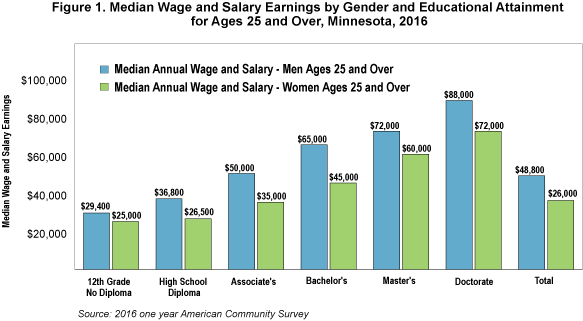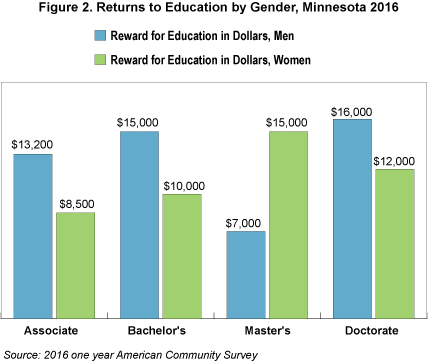
by Sanjukta Chaudhuri
March 2018
Women in Minnesota earn less than men, even when they have the same level of education.
Conventional wisdom suggests that women who want to rise up the career ladder like men should seek the most education possible. Earnings gaps, however, exist even among women and men with the same amount of education.
Postsecondary education is expensive. Without equal rewards, the rates at which women and men recover these costs will differ, giving women a worse deal than men. Moreover, unequal gender rewards for the same higher education credential contradicts the very notion of removing barriers to success through postsecondary education.
This article examines educational attainment and returns by gender in Minnesota. The most recent five-year American Community Survey (ACS) micro-data (2012 to 2016) for Minnesota is used for the analysis. The educational levels examined are high school diploma, associate degree, bachelor's degree, master's degree and doctoral degree. The analysis includes all Minnesota workers who were at least 25 years old and reported being employed.
Most people consider a postsecondary education credential a powerful equalizer that can catapult anyone onto a successful career path. The sheer force of educational credentials can help overcome other forms of systemic barriers to success.
In fact, higher levels of educational attainment are associated with significantly higher labor market earnings. According to the Minnesota Office of Higher Education, the average annual expense for a resident undergraduate attending a Minnesota college full time in 2016 ranged from $14,420 to $49,107. The higher earnings that accrue over one's career and into retirement, however, usually compensate for the high investment cost. Advanced degrees also improve job stability, career mobility and salary progression.
Minnesota is often lauded as one of the most educated states in the country. In 2016, 46 percent of Minnesotans ages 25 and over had at least completed an associate degree, while 34 percent had completed at least a bachelor's degree. The gendered breakdown of educational attainment shows slightly more educational credentials among women than men. As shown in Table 1, 48 percent of women earned at least an associate degree compared with 45 percent of men, while 35 percent of women earned a bachelor's degree compared with 34 percent of men. Slightly higher percentages of women earned educational credentials up to the master's level. Slightly higher percentages of men earned professional and doctoral degrees.
| Table 1. Percent Frequency Distribution of Educational Attainment in Minnesota, 2016 | |||
|---|---|---|---|
| All (%) | Women (%) | Men (%) | |
| Less than High School | 7.1 | 6.5 | 7.7 |
| Regular High School Diploma | 21.8 | 21.4 | 22.2 |
| GED or Alternative Credential | 3.2 | 2.4 | 4.1 |
| Some College, No Degree | 21.5 | 21.6 | 21.4 |
| Associate Degree | 11.9 | 13.1 | 10.8 |
| Bachelor's Degree | 22.9 | 23.3 | 22.5 |
| Master's Degree | 8.2 | 9.0 | 7.5 |
| Professional Degree Beyond a Bachelor's Degree | 2.0 | 1.6 | 2.4 |
| Doctorate Degree | 1.3 | 1.0 | 1.7 |
| Total | 100 | 100 | 100 |
| Universe | 3,739,904 | 1,904,539 | 1,835,365 |
| Source: 2016 one-year American Community Survey | |||
This article presents gross returns on higher education credentials using data from the 2016 American Community Survey. In 2016, among employed workers ages 25 and over in Minnesota, median annual wage and salary income was $37,500 for high school graduates. This increased to $40,000 for those with an associate degree. Therefore, the return from getting an associate degree over a high school diploma was $2,500 or 6.7 percent.
The median salary for bachelor's degree holders ($50,000) was an increase of $10,000 or 25 percent, over associate degree holders. The median salary for master's degree holders was $65,000, an increase of $15,000 or 30 percent over a bachelor's degree. The median salary for doctoral degree holders was $78,000, an increase of $13,000 or 20 percent over a master's degree. Note that these estimates are gross returns. In order to get the net returns from higher educational credentials, one would have to subtract the cost of education.
This article uses two standard ways of defining the gender earnings gap. The first is called the gender earnings ratio, which measures women's median annual earnings as a percentage of men's median annual labor market earnings.
The second measure is the gender earnings gap, which shows the gap between men and women's earnings as a percentage of men's earnings.
Despite statistics clearly demonstrating gender equality in access to postsecondary educational attainment, Minnesota has an earnings gender gap at every level of education (see Figure 1). For both men and women, median earnings increase at every level of educational credential.

For the most part, the gender earnings gap widens as education increases. Men without a high school diploma earn 15 percent more than women without a diploma (an additional $4,400 a year), while men with a high school diploma earn 28 percent more than women with a diploma ($10,300 more a year).
The male-female earnings gap increases to 30 percent ($15,000 a year) with an associate degree and 31 percent ($20,000 a year) with a bachelor's degree. The gap then begins to narrow at the master's degree level, with men earning 17 percent more than women with the same degree ($12,000 a year). At the doctorate level, men earn 18 percent more than women with a doctorate ($16,000 a year).
The previous discussion reveals that the gender earnings gap does not disappear with higher educational credentials. Figure 2 shows that men receive higher rewards for completing higher educational credentials at all degree levels except master's degree.

Men increased their annual wage and salary incomes by $13,200 (36 percent) after gaining an associate degree, while women increased their earnings by $8,500 (32 percent) for the same degree. The salary growth for bachelor's degree completers over associate degree completers was $15,000 (30 percent) for men and $10,000 (29 percent) for women. Only at the master's level do women see higher rewards than men. For women, the salary increase for earning a master's degree was $15,000 (33 percent) compared with $7,000 (11 percent) for men. Finally, at the doctoral level, the men's premium is once again higher at $16,000 (22 percent) compared with $12,000 (20 percent) for women.
Choice of college major, or field of study, is a big factor in determining salaries. If women tend to track into majors that lead to lower salaries for the same degree level, then it would be a significant factor in explaining why earnings for women and men with the same degree differ. If women tend to choose fields of study that command lower salaries, this could explain some or all of the gender earnings gaps by education. Table 2 shows the five most popular choices at the bachelor's degree award level. (Note that the ACS has data on field of study only at the bachelor's degree level.)
| Table 2. Top Five Fields of Study and Median Annual Salary at Bachelor's Degree Level by Gender | |||||
|---|---|---|---|---|---|
| Women, Bachelor Degree Completers | Men, Bachelor Degree Completers | ||||
| Field of study at Bachelor's level | Field of Study Graduated With as a Percentage of all Women who are Bachelor's Degree Holders | Median Annual Salary (Women) | Field of Study at Bachelor's Level | Field of Study Graduated With as a Percentage of all Women who are Bachelor's Degree Holders | Median Annual Salary (Men) |
| Business | 20.3 | $45,000 | Business | 28.5 | $55,000 |
| Education Administration and Teaching | 18.3 | $11,000 | Engineering | 11.5 | $68,000 |
| Medical and Health Sciences
and Services |
12.1 | $40,000 | Social Sciences | 7.5 | $50,000 |
| Communications | 5.7 | $36,500 | Education Administration and Teaching | 7.4 | $46,100 |
| Social Sciences | 5.4 | $25,000 | Computer and Information Sciences | 4.9 | $45,000 |
| Source: 2016 one-year American Community Survey | |||||
A good starting point for assessing whether choice of field of study is a potential cause of the gender gap is to investigate whether the top choices differ between women and men.
At the bachelor's level, three fields of study are in the top five list for both men and women. These are business, education administration and teaching, and social sciences. Yet among bachelor's degree holders within each field of study, the median salaries are consistently lower for women than men. For instance, the median salary for women with a business degree is $45,000 as opposed to $55,000 for men.
There are also a few fields that are more popular among women and others that are more popular among men. For women this is medical and health sciences and services. For men it is engineering. As shown in Table 2, women with bachelor's degrees in medical and health sciences and services earn less than men with engineering degrees.
Overall, there are some elements of similarity as well as dissimilarity between the fields of study chosen by men and women. For the sake of keeping the analysis manageable, the previous analysis was limited to the top five fields of study. Without more in-depth research, a firm conclusion on the link between choice of field of study and median salaries cannot be reached. What is clear, though, is that even for the same field of study, women earn less than men. This suggests that even after adjusting for field of study, gender bias in returns on education potentially lingers.
This article provides a preliminary overview of gender gaps after postsecondary education in Minnesota. Further analysis is needed to estimate the adjusted dollar value and percentage returns from higher education. Choice of college major, occupational choice, industry, hours of work, marital status, family composition, residence, age and work experience all could have significant impacts on labor market earnings. Furthermore, other factors such as soft skills are harder to measure but nonetheless impact work performance, salary and salary growth.
Finally, it is important to drill deeper to the intersection of gender and race and ethnicity by education. For instance, in Minnesota in 2016, at the bachelor's degree level, non-Hispanic white men earned $67,000 at the median, while non-Hispanic white women earned $45,000 and women of minority races earned even less. Black/African American women earned $41,000 or 39 percent less than Caucasian men. Hispanic women with a bachelor's degree earned $33,900, or 49 percent less, while Asian American women earned $40,000 or 40 percent less than Caucasian men.
Minnesota has work to do to break down racial barriers that linger after a postsecondary education. Future research should look at women of minority race and ethnicity and their labor market outcomes.